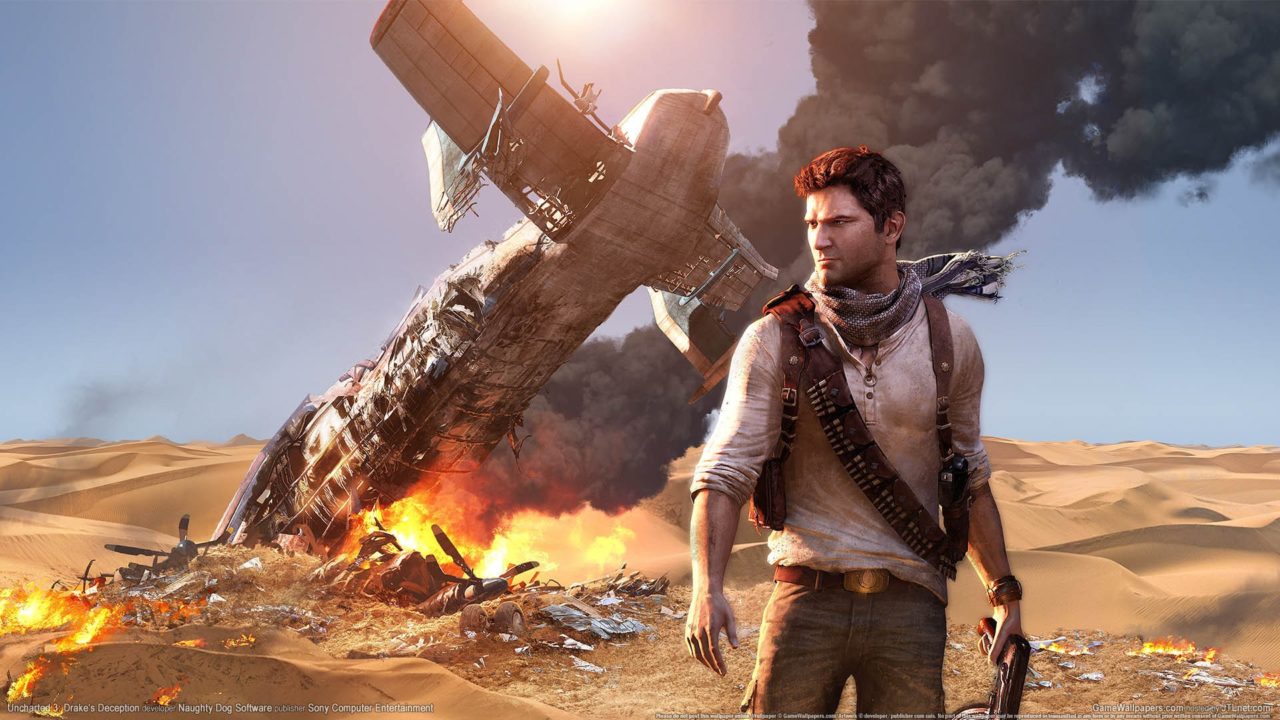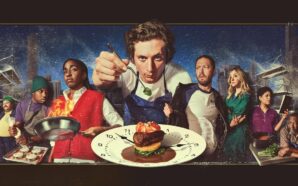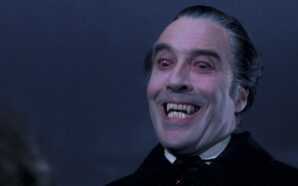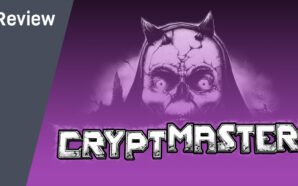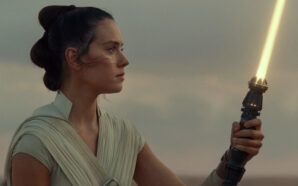Uncharted 3 is a game of great ambitions. It tries to do so much, expand on so much, and if effort was the only metric on which to judge, it would be the best game in the series so far. But, maybe because of its rapid two-year development, it stumbles, and almost every story element feels half-baked. Even some of the gameplay additions are executed poorly. Uncharted 3 is undoubtably a good game and a solid entry in the franchise but, on my latest revisit after years away, I couldn’t help but pick up on its flaws.
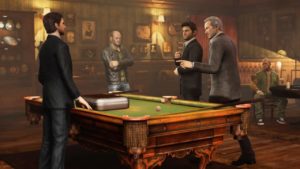 Take the opening for example. London, a city composed purely of bald white men and yellow piping, according to the game, is Nate’s first stop on his latest quest and there’s nothing like a dust-up in an English pub. Yet it’s not a good way to begin the game and show off its new combat features. Hand-to-hand has never been one of the series’ strengths but it has been improved in the third entry, especially when jumping from a higher level onto an enemy or catching their gun satisfyingly after a punch. These improvements come from interacting with a large environment so having the game’s opening be a brawl in the small tight rooms of a pub, with no guns and the only attack being spamming the square button, is a big mistake. Although, it’s hard to dislike any game that lets you smack people on the head with a frying pan within the first five minutes.
Take the opening for example. London, a city composed purely of bald white men and yellow piping, according to the game, is Nate’s first stop on his latest quest and there’s nothing like a dust-up in an English pub. Yet it’s not a good way to begin the game and show off its new combat features. Hand-to-hand has never been one of the series’ strengths but it has been improved in the third entry, especially when jumping from a higher level onto an enemy or catching their gun satisfyingly after a punch. These improvements come from interacting with a large environment so having the game’s opening be a brawl in the small tight rooms of a pub, with no guns and the only attack being spamming the square button, is a big mistake. Although, it’s hard to dislike any game that lets you smack people on the head with a frying pan within the first five minutes.
Nathan Drake in a suit, wielding a silenced pistol, investigating a conspiracy in the UK is essentially the James Bond game I always wanted. I’m sure the similarities are no accident either considering the game’s iconic plane sequence is heavily inspired by the similar scene in The Living Daylights. Uncharted 3’s opening act feels unique in the series and the brief escapade to a modern, inhabited city is refreshing, exploring more modern history and locations without losing the franchise’s identity. The enemies inhabiting London’s streets are less successful, however. The suited men with dark sunglasses are a mysterious foil initially but they never become more than that. Motivation or ideology is barely explored and they remain a generic secret society for the entirety of the game, spearheaded by the intriguing but ultimately uninspired Marlowe.
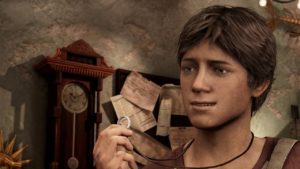 The London section is interrupted by perhaps the most beloved part of the game, something I can’t help but gush about: the flashback to young Drake. I remember this being a fantastic surprise at the time the game was released, remaining unspoiled and taking the series to new emotional depths. While the game may eventually scupper it, the set-up of this story being about Nate and Sully’s relationship is wonderful. Their closeness was surprisingly absent in the previous two games, with Sully’s screentime much shorter than I remember, but Uncharted 3 fleshes out their relationship and the importance of their bond. The reprisal of their first mission together as, possibly, their last is solid full-circle storytelling and immediately makes the player invested in what is otherwise a stock narrative. The developers now have no qualms with taking their time and building up emotional investment without constant action. The sequence is a big step forward for Naughty Dog, as well as just being a joy to play.
The London section is interrupted by perhaps the most beloved part of the game, something I can’t help but gush about: the flashback to young Drake. I remember this being a fantastic surprise at the time the game was released, remaining unspoiled and taking the series to new emotional depths. While the game may eventually scupper it, the set-up of this story being about Nate and Sully’s relationship is wonderful. Their closeness was surprisingly absent in the previous two games, with Sully’s screentime much shorter than I remember, but Uncharted 3 fleshes out their relationship and the importance of their bond. The reprisal of their first mission together as, possibly, their last is solid full-circle storytelling and immediately makes the player invested in what is otherwise a stock narrative. The developers now have no qualms with taking their time and building up emotional investment without constant action. The sequence is a big step forward for Naughty Dog, as well as just being a joy to play.
Yet while the emotional storytelling expands, so does the historical, and this leads to a more muddled plot than previous games. There are elements of the mythology I like a lot but there’s just too much of it. Instead of simply following Francis Drake’s trail, or Marco Polo’s, like games past, Uncharted 3 throws 11th century crusaders, Elizabethan magic obsessives, and T.E. Lawrence into the mix. There’s not one trail but several, intertwined through time, which is too much for what is only meant to be backstory for the actual plot, and also makes the game feel disjointed. Uncharted 2 was a single continuous sequence of events in the style of an adventure serial. Uncharted 3 is more stop and start and the narrative flow suffers, with the traveling from country to county feeling far from fluid. I’ve played the game several times but I still had to pause it on occasion to quote Sully: “Remind me again why we’re doing this”.
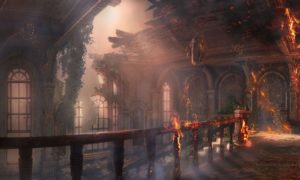 Another reason why the story, particularly in the game’s first half, doesn’t flow is that you can feel the thought processes of the developers while playing. “What locations haven’t we included in this series yet?” And, of course, they include all of them, from the London Underground to Yemeni desert. “What technological advancements do we want to master this time?” The answer is fire, sand, and sea, with sequences featuring all of them just for the sake of it. Uncharted 3 is a game built around set pieces and a desire to one up the train scene from Uncharted 2. This may make for an unwieldy whole but those sequences and the moment-to-moment gameplay is superb. This revisit is taking on the role more of a narrative and structural analysis so I need to make clear that the action and the scale of the gameplay is brilliant. And not just the famous moments from later in the game. I was impressed by everything in the French chateau, particularly its fiery end.
Another reason why the story, particularly in the game’s first half, doesn’t flow is that you can feel the thought processes of the developers while playing. “What locations haven’t we included in this series yet?” And, of course, they include all of them, from the London Underground to Yemeni desert. “What technological advancements do we want to master this time?” The answer is fire, sand, and sea, with sequences featuring all of them just for the sake of it. Uncharted 3 is a game built around set pieces and a desire to one up the train scene from Uncharted 2. This may make for an unwieldy whole but those sequences and the moment-to-moment gameplay is superb. This revisit is taking on the role more of a narrative and structural analysis so I need to make clear that the action and the scale of the gameplay is brilliant. And not just the famous moments from later in the game. I was impressed by everything in the French chateau, particularly its fiery end.
Uncharted 3 is trying to tell a richer thematic story than its predecessors and I appreciate its attempt. Some of it is successful, like the aforementioned young Drake sequence, and even though the ending refuses to drive its points home (more on that in a minute) I like that the story is actually trying to say something. ‘This time it’s personal’ is a cliché to be sure but here its true and purposeful. This adventure is the one Nate’s entire career as a thief has been building to. His first quest relating to his apparent heritage has been reignited but it could prove too dangerous to pursue. Instead of Drake’s Deception, the game could be subtitled ‘Drake’s Pride’. Sully comments that that is what will get them all killed and that Nate needs to go on a journey of letting go rather than reaching for something. It’s a great thematic underpinning but does he learn his lesson by the end? Yes and no, and that’s a frustrating answer.
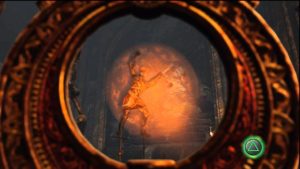 After the section in France, the game moves to Syria to repeat the same beats but this time with more people. I appreciate the time spent with just Nate and Sully, a vital relationship, but I wish the two sections could have been merged to stop them feeling so repetitive. Thankfully, Syria offers larger battlegrounds than those seen before and the action remains engaging. And while the performances are phenomenal, the game places so much focus on Cutter during the Syria mission that I’m glad he breaks his legs and can’t continue on. Nate’s quest suddenly has stakes for the people around him. It’s also worth noting that Uncharted 3 has by far the best puzzles out of any of the games. I was disappointed in this aspect in the first two games and they’ve radically improved in the third.
After the section in France, the game moves to Syria to repeat the same beats but this time with more people. I appreciate the time spent with just Nate and Sully, a vital relationship, but I wish the two sections could have been merged to stop them feeling so repetitive. Thankfully, Syria offers larger battlegrounds than those seen before and the action remains engaging. And while the performances are phenomenal, the game places so much focus on Cutter during the Syria mission that I’m glad he breaks his legs and can’t continue on. Nate’s quest suddenly has stakes for the people around him. It’s also worth noting that Uncharted 3 has by far the best puzzles out of any of the games. I was disappointed in this aspect in the first two games and they’ve radically improved in the third.
No character personifies my feelings towards Uncharted 3 more than Talbot, Marlowe’s mysterious second-in-command. He’s an intriguing villain who can turn a corner and immediately disappear, can be shot but survive without a mark on him, make huge supernatural leaps, and has a weird connection with Tarot cards. This is all good set-up to a reveal that never comes. There’s no answer to any of it, no final purpose behind it. Apparently, he was at one point going to be a Djinn, a supernatural being, but that was cut from the final game and after hours of teasing nothing comes of him. The game threatens a supernatural excursion but never makes good on it; the demons at the end of the game are nothing but hallucinations and the big spiders are just a bit naff. The scary part of spiders are the long legs but the ones in the game are all bulbous body, which is hardly creepy.
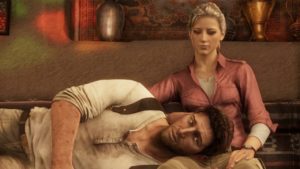 Nate’s personal life is brought into greater focus in Uncharted 3 but, again, not quite to a satisfying extent. It feels more like a half measure before Uncharted 4 goes all the way. His between-games break-up with Elena feels like a repeat of Uncharted 2 except this time they had a more committed relationship. How committed is only hinted at for most of the game however. There are references to rings but the issue is Nate and Elena refuse to talk about their situation despite it feeling natural to do so. It’s not until the final scene where we get any insight. When the game pauses for a conversation, like it does with a captured Nate and Marlowe, we can see that there is actual depth to be mined. I love finding out about Nate’s past at the orphanage and that he’s been lying to himself about being a Drake. It makes his quest that much more personal and complex.
Nate’s personal life is brought into greater focus in Uncharted 3 but, again, not quite to a satisfying extent. It feels more like a half measure before Uncharted 4 goes all the way. His between-games break-up with Elena feels like a repeat of Uncharted 2 except this time they had a more committed relationship. How committed is only hinted at for most of the game however. There are references to rings but the issue is Nate and Elena refuse to talk about their situation despite it feeling natural to do so. It’s not until the final scene where we get any insight. When the game pauses for a conversation, like it does with a captured Nate and Marlowe, we can see that there is actual depth to be mined. I love finding out about Nate’s past at the orphanage and that he’s been lying to himself about being a Drake. It makes his quest that much more personal and complex.
Nate’s kidnap and escape from pirates may be an unnecessary story excursion, the closest an Uncharted game can get to a side mission, but it is by far the best part of the game and a contender for the best hour or two of the franchise. From a gameplay perspective, everything just works. It’s also surprisingly difficult in certain areas. There are several planes of battle from swimming underwater to climbing on the masts of ships, mixing gunplay with the new combat, and even environmental changes with the approaching storm. It is a perfect showcase of Uncharted 3’s improvements and the franchise’s winning formula. While the plane sequence is very good, I think the cruise ship, named the Seaward in what I have to guess to be an Arrested Development reference, beats it and even comes close to topping the train mission from Uncharted 2. It’s a perfect set piece that just keeps escalating.
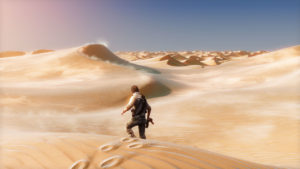 Wisely, the game follows up its back-to-back spectacular vehicle crashes with another notably great sequence, this time one unique in the series. Landing in the Rub’ al Khali desert, Nate wanders in search of civilisation and water and begins to hallucinate as we hear Marlowe recite T.S. Elliot’s The Waste Land. It’s such an atmospheric sequence, mixing the majesty of Lawrence of Arabia with genuinely unsettling gameplay. All you have to do is walk but I’m so glad it’s playable rather than a cutscene because there’s such a potent sense of directionless as you push forward into nothing but dunes and certain death. Thankfully, Nate survives and soon engages a convoy and finds the lost city, and the bottled demons within, in a fun action climax. It’s enjoyable to play but the themes and the characters’ personal journeys don’t stick the landing.
Wisely, the game follows up its back-to-back spectacular vehicle crashes with another notably great sequence, this time one unique in the series. Landing in the Rub’ al Khali desert, Nate wanders in search of civilisation and water and begins to hallucinate as we hear Marlowe recite T.S. Elliot’s The Waste Land. It’s such an atmospheric sequence, mixing the majesty of Lawrence of Arabia with genuinely unsettling gameplay. All you have to do is walk but I’m so glad it’s playable rather than a cutscene because there’s such a potent sense of directionless as you push forward into nothing but dunes and certain death. Thankfully, Nate survives and soon engages a convoy and finds the lost city, and the bottled demons within, in a fun action climax. It’s enjoyable to play but the themes and the characters’ personal journeys don’t stick the landing.
The failure of Nate’s story is twofold. Firstly, Sully should have died for real. We see him shot and Nate’s heartbroken reaction, certainly a bigger reaction than when it happened in the first game, but then it is revealed to be a hallucination brought on by tainted water. It’s all too similar to Scarecrow fear toxin from Batman, and Talbot already has powerful hallucinogens so why is this find such a big deal? Sully’s survival means that Nate learns nothing. He’s prideful and drags others on his adventure and there is none of the cost that the game has been teasing. He has his cake and eats it too: he finds the city, completes the quest, and loses nothing. Secondly, the game could have been a ‘war of the rings’ for Nathan. Francis Drake’s ring and all it represents vs his engagement ring with Elena and what that represents. Marlowe uses Drake’s ring to tempt him at the end of the game but he refuses and lets it, and her, sink into the sand. Yet this isn’t much of a decision; this isn’t his ‘Last Crusade’ moment. The ring at that point is useless, its role is done, and he’s finished his quest.
 Uncharted 3 is a game brimming with potential. If it succeeded at everything it attempted it would be the best of the original trilogy. The gameplay, while very similar to Uncharted 2, is refined and Naughty Dog are confident storytellers. Yet the more a game takes on the more chance of failure there is, and while it pains me to indicate that an Uncharted game is a failure, Uncharted 3 ends in a frustrating place. The many plot and thematic strands aren’t neatly tied up or fully seized upon. It’s ambitious, occasionally brilliant, but ultimately flawed.
Uncharted 3 is a game brimming with potential. If it succeeded at everything it attempted it would be the best of the original trilogy. The gameplay, while very similar to Uncharted 2, is refined and Naughty Dog are confident storytellers. Yet the more a game takes on the more chance of failure there is, and while it pains me to indicate that an Uncharted game is a failure, Uncharted 3 ends in a frustrating place. The many plot and thematic strands aren’t neatly tied up or fully seized upon. It’s ambitious, occasionally brilliant, but ultimately flawed.
Am I being too harsh on Uncharted 3: Drake’s Deception? Let me know in the comments and be sure to geek out with me about TV, movies and video-games on Twitter @kylebrrtt.




